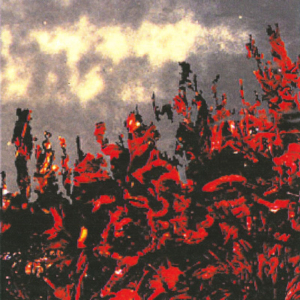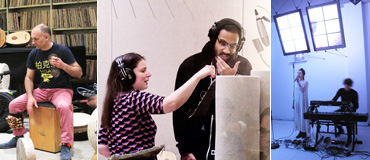Susie Kozawa and Jesse Minkert | Nearly Seen, Closely Heard
 November – December, 1999
November – December, 1999
Nearly Seen, Closely Heard, an interactive multimedia installation, was the inaugural work for the Jack Straw New Media Gallery. The installation is an audio and visual collage of Kozawa’s recordings of found and ambient sounds and Minkert’s projections of computer-animated photographs.
The soundscape and visual images have been digitally programmed to respond to audience movement in the space. The installation comprises thirteen animated movies and 140 individual sounds. As people move through the room, a video camera on the ceiling senses their presence and sends that information to a computer which triggers different animations and sound sequences. Voices whisper numbers and colors, marbles roll over drumheads, bagpipes fill the room. An image of an old neon sign transforms into a drive-in theater screen. The bark of a tree splits into a blanket of bright red leaves and drifting clouds. The movies and sounds constantly shift through subtle progressions. Each viewer’s experience will be different, depending on their movement in the room and whether other people are present.
Both Susie and Jesse used sounds and images they collected from everyday life as a starting point for their work. Susie recorded over a hundred sounds from a variety of sources over several years. She then used Protools digital editing software to create a palette of sounds for each of Jesse’s movies. Jesse took a series of still photographs which he scanned and then manipulated using Photoshop. He then used Photoshop to create the individual cells for a series of short, animated movies. The individual cells were then edited and converted using Premier into quicktime movies.
The software used to create this installation is based on the programming environment called MAX, a graphical, object oriented, musical/multimedia programming tool that allows composers and artists to create interactive systems in a very intuitive way. There is an addition to MAX called MSP that allows direct manipulation and synthesis in unlimited ways. The sensing of viewers/listeners in the space is done by the “Very Nervous System,” a software that interprets video images of people moving through space by tracking the changes in each pixel in the video frame and sending this information to MAX/MSP where decisions are made about how to reach to these changes, in this case triggering the animated images and sounds.
Artists
Susie Kozawa
Susie Kozawa, a sound artist, composer and performer, works mostly with sound collages and site-specific installations, in which the gathering of sounds is a primary activity. She explores different…
READ MORE >Jesse Minkert
Jesse Minkert’s work has appeared in about fifty literary journals including the Cream City Review, Confrontation, Mount Hope, the Floating Bridge Review, the Minetta Review, Poetry Northwest, Common Knowledge…
READ MORE >




